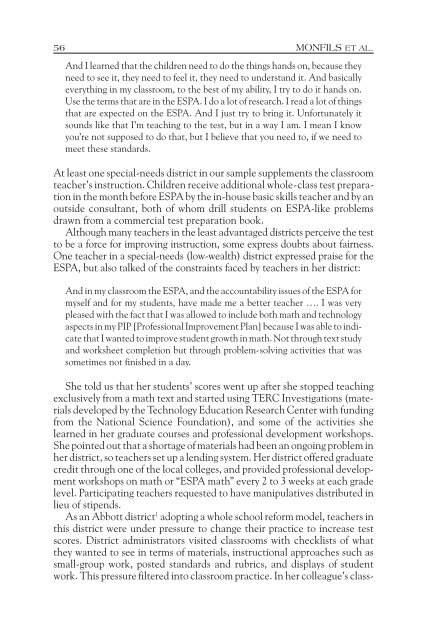The Ambiguity of Teaching to the Test Standards
The Ambiguity of Teaching to the Test Standards
The Ambiguity of Teaching to the Test Standards
You also want an ePaper? Increase the reach of your titles
YUMPU automatically turns print PDFs into web optimized ePapers that Google loves.
56 MONFILS ET AL.<br />
And I learned that <strong>the</strong> children need <strong>to</strong> do <strong>the</strong> things hands on, because <strong>the</strong>y<br />
need <strong>to</strong> see it, <strong>the</strong>y need <strong>to</strong> feel it, <strong>the</strong>y need <strong>to</strong> understand it. And basically<br />
everything in my classroom, <strong>to</strong> <strong>the</strong> best <strong>of</strong> my ability, I try <strong>to</strong> do it hands on.<br />
Use <strong>the</strong> terms that are in <strong>the</strong> ESPA. I do a lot <strong>of</strong> research. I read a lot <strong>of</strong> things<br />
that are expected on <strong>the</strong> ESPA. And I just try <strong>to</strong> bring it. Unfortunately it<br />
sounds like that I’m teaching <strong>to</strong> <strong>the</strong> test, but in a way I am. I mean I know<br />
you’re not supposed <strong>to</strong> do that, but I believe that you need <strong>to</strong>, if we need <strong>to</strong><br />
meet <strong>the</strong>se standards.<br />
At least one special-needs district in our sample supplements <strong>the</strong> classroom<br />
teacher’s instruction. Children receive additional whole-class test preparation<br />
in <strong>the</strong> month before ESPA by <strong>the</strong> in-house basic skills teacher and by an<br />
outside consultant, both <strong>of</strong> whom drill students on ESPA-like problems<br />
drawn from a commercial test preparation book.<br />
Although many teachers in <strong>the</strong> least advantaged districts perceive <strong>the</strong> test<br />
<strong>to</strong> be a force for improving instruction, some express doubts about fairness.<br />
One teacher in a special-needs (low-wealth) district expressed praise for <strong>the</strong><br />
ESPA, but also talked <strong>of</strong> <strong>the</strong> constraints faced by teachers in her district:<br />
And in my classroom <strong>the</strong> ESPA, and <strong>the</strong> accountability issues <strong>of</strong> <strong>the</strong> ESPA for<br />
myself and for my students, have made me a better teacher …. I was very<br />
pleased with <strong>the</strong> fact that I was allowed <strong>to</strong> include both math and technology<br />
aspects in my PIP [Pr<strong>of</strong>essional Improvement Plan] because I was able <strong>to</strong> indicate<br />
that I wanted <strong>to</strong> improve student growth in math. Not through text study<br />
and worksheet completion but through problem-solving activities that was<br />
sometimes not finished in a day.<br />
She <strong>to</strong>ld us that her students’ scores went up after she s<strong>to</strong>pped teaching<br />
exclusively from a math text and started using TERC Investigations (materials<br />
developed by <strong>the</strong> Technology Education Research Center with funding<br />
from <strong>the</strong> National Science Foundation), and some <strong>of</strong> <strong>the</strong> activities she<br />
learned in her graduate courses and pr<strong>of</strong>essional development workshops.<br />
She pointed out that a shortage <strong>of</strong> materials had been an ongoing problem in<br />
her district, so teachers set up a lending system. Her district <strong>of</strong>fered graduate<br />
credit through one <strong>of</strong> <strong>the</strong> local colleges, and provided pr<strong>of</strong>essional development<br />
workshops on math or “ESPA math” every 2 <strong>to</strong> 3 weeks at each grade<br />
level. Participating teachers requested <strong>to</strong> have manipulatives distributed in<br />
lieu <strong>of</strong> stipends.<br />
As an Abbott district 1 adopting a whole school reform model, teachers in<br />
this district were under pressure <strong>to</strong> change <strong>the</strong>ir practice <strong>to</strong> increase test<br />
scores. District administra<strong>to</strong>rs visited classrooms with checklists <strong>of</strong> what<br />
<strong>the</strong>y wanted <strong>to</strong> see in terms <strong>of</strong> materials, instructional approaches such as<br />
small-group work, posted standards and rubrics, and displays <strong>of</strong> student<br />
work. This pressure filtered in<strong>to</strong> classroom practice. In her colleague’s class-



